We've been in the Philippines for about a week now. We landed at Clark Air Base at sunset and walked off the plane into a sea of humidity, stink, heat and smog. Clark is an old American air field now doing duty as a commercial airport popular with budget airlines. We got some recommendations from the helpful info desk at the airport and took a taxi to the Clarkton Hotel. The Clarkton is a respectable place and even has a fancy new wing. Still, it was full of American and German men here to meet women, many of whom cruised the bar and pool at night while Laura and I innocently paddled around in the deep end. The hotel had a club featuring hourly 'heritage dancers' -- girls in bikinis.
From Clark we headed north to Vigan, a UNESCO World Heritage Site. Vigan was one of the few Philippine cities to escape WW2 bombing; it's historic core is thick with cobblestone streets, horsedrawn carriages, 16th century churches and old mansions.
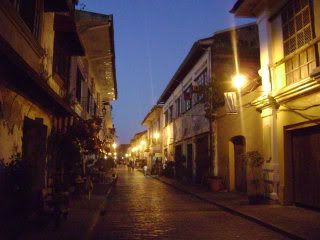
From Vigan we wanted to head west, to Bontoc, which stands in the heart of the north Luzon highlands. From Vigan there are two ways to get there -- the conventional and very long way or the unconventional shortcut. A guy at the bus station actually mapped it out for us: catch a 7:30 bus from Vigan south to a crossroads, get out and take a bus to Cervantes, and then catch another bus to Bontoc. If it all went well, we could be there by 2 p.m.
It didn't go well. We got to the crossroads no problem, but then waited 45 minutes for the Cervantes bus to fill up. When it did leave it followed one of the most hairraising roads I've ever been on -- we went from sea level to 4,000 feet and most of the way back to sea level in the span of 20 miles. Along the way were fragrant pine forests and tiny villages. In one village girls were marching around the playground, some holding flags and some playing huge xylophones.
Cervantes was a small town but seemed quiet even by small town standards. Notably, there was no bus to go to Bontoc. After some asking around I found out why: the bridge a mile or two out of town has been dismantled, and vehicles could not make it across the river. Now we were stuck. We took a motorized tricycle to the bridge and walkd across its rickety span.
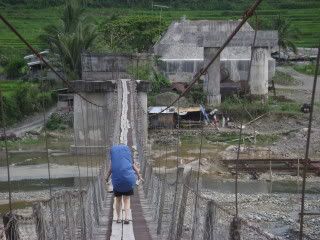
On the other side we waited and caught a ride in a gravel truck taking stones from the river. Almost right away the truck got a flat. Then, carrying a few tons of rock, it climbed 2,000 vertical feet over 6 miles at a pretty steady 4 mph. It dumped its load and we hopped into a Toyota, whose driver was picking people up randomly across the mountains and acting like a shared taxi. That got us to the main road, where we waited a few minutes for a real bus, which got us to Bontoc by 5 p.m. Fun!
At dinner that night we met a Canadian man and his Khmer wife who had a rented car. They picked us up the next morning and we went to Sagada, another 2,000 feet up. Sagada is quiet and calm and surrounded by pine forests. We hiked to a hill with hanging coffins -- much like those in Tana Toraja, Sulawesi -- and hiked into a cave with coffins stacked at its entrance.
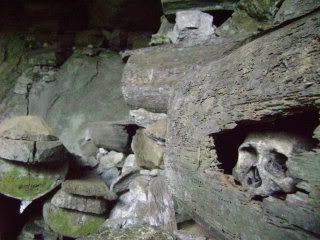
Then we had one of the best coffees of the trip before heading back to Bontoc. In the afternoon I walked to a nearby rice field and met Mary, a local who talked my ear off and asked very detailled questions about American fiscal policy. When I asked to take her picture she said, 'No, because I am ugly.'
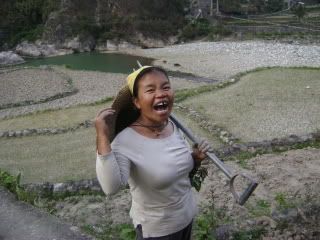
In the morning we caught a jeepney up the mountain. Of all the forms of transportation in the world, the jeepney is surely among the most unique. Modelled after an American service Jeep, they are made of stainless steel but wildly colorful. The bed is about 16 feet long and has two rows of benches. A lot of people get stuffed into these things.
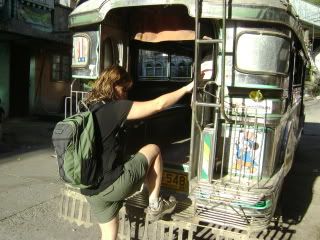
Our jeepney was stuffed with Laura and I and about a dozen women headed up the mountain to their rice fields. They were all old, wrinkled and chatty. Some of the older ones had tattoos up and down their arms worn to ward off disease -- like smallpox, we were told. Others wore homemade jewelry and headbands made out of snake skeletons which are meant to discourage lightning strikes.
The mountains around Bontoc are known for their terraced rice fields. A handful are designated UNESCO World Heritage Sites. We rode the jeepney until it hit fields and hiked up for an hour. Along the way boys working in the forest pointed out which trail to take. We hiked higher and higher; they hiked down with enormous loads of fresh-cut pine on their shoulders. From the top the high country of Luzon spread out in four directions. The rice terraces hopped and skipped down the mountain in a cascade of color.

1 comment:
I think arranging the transportation alone would do me in--not to mention the language, finding adequate food and a place to sleep, etc, etc. Being a good traveler is an art form.
Post a Comment